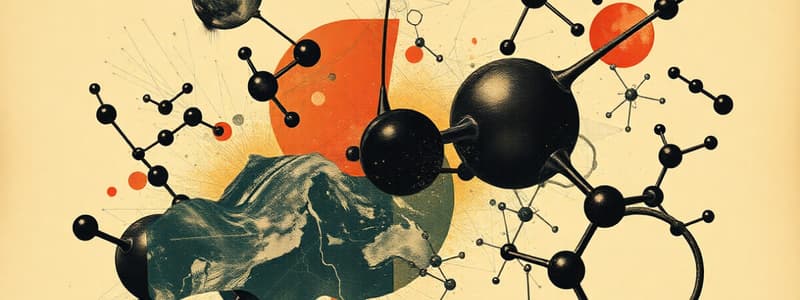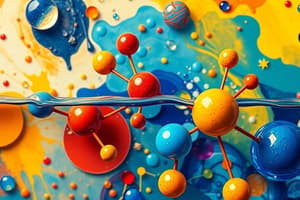Podcast
Questions and Answers
Which six elements are primary components of living things?
Which six elements are primary components of living things?
- Oxygen, Hydrogen, Sodium, Calcium, Carbon, Nitrogen
- Carbon, Hydrogen, Oxygen, Nitrogen, Phosphorus, Sulfur (correct)
- Carbon, Nitrogen, Silicon, Phosphorus, Oxygen, Magnesium
- Helium, Hydrogen, Carbon, Sulfur, Calcium, Nitrogen
Water is a non-polar molecule.
Water is a non-polar molecule.
False (B)
What is the term for the interactions between water molecules due to their polar nature?
What is the term for the interactions between water molecules due to their polar nature?
hydrogen bonding
Water makes up about ________% of the human body.
Water makes up about ________% of the human body.
Match the following terms with their descriptions:
Match the following terms with their descriptions:
Which of the following functional groups is associated with amino acids?
Which of the following functional groups is associated with amino acids?
Hydrophilic substances mix well with hydrophobic substances.
Hydrophilic substances mix well with hydrophobic substances.
Name a property of oil that prevents it from mixing with water.
Name a property of oil that prevents it from mixing with water.
The functional group that typically contains a nitrogen atom and is found in amino acids is called an ______.
The functional group that typically contains a nitrogen atom and is found in amino acids is called an ______.
Match the functional groups with their characteristics:
Match the functional groups with their characteristics:
Which of the following statements accurately describes hydrophobic molecules?
Which of the following statements accurately describes hydrophobic molecules?
The carboxyl functional group is nonpolar.
The carboxyl functional group is nonpolar.
Name two biological important functional groups.
Name two biological important functional groups.
The atoms that provide particular properties to organic molecules are called __________.
The atoms that provide particular properties to organic molecules are called __________.
Match the following functional groups with their properties:
Match the following functional groups with their properties:
Which of these functional groups is known for cross-linking in proteins?
Which of these functional groups is known for cross-linking in proteins?
Phosphate groups are only found in proteins.
Phosphate groups are only found in proteins.
What type of molecule backbone do organic molecules have?
What type of molecule backbone do organic molecules have?
What best describes the nature of water as a molecule?
What best describes the nature of water as a molecule?
Water has a slightly positive charge on the oxygen side.
Water has a slightly positive charge on the oxygen side.
What term is used to describe substances that do not mix well with water?
What term is used to describe substances that do not mix well with water?
Water is a ___________ compound that constitutes about 60% of the human body.
Water is a ___________ compound that constitutes about 60% of the human body.
Match the following terms with their definitions:
Match the following terms with their definitions:
Which of the following characteristics is true about the carboxyl group?
Which of the following characteristics is true about the carboxyl group?
Oil is a hydrophilic compound that readily mixes with water.
Oil is a hydrophilic compound that readily mixes with water.
What causes water and oil to separate instead of mixing?
What causes water and oil to separate instead of mixing?
The ______ functional group is crucial in forming phospholipids.
The ______ functional group is crucial in forming phospholipids.
Match the following functional groups with their characteristics:
Match the following functional groups with their characteristics:
Which of the following functional groups is found in carbohydrates and nucleic acids?
Which of the following functional groups is found in carbohydrates and nucleic acids?
Hydrophobic molecules tend to mix well with hydrophilic substances.
Hydrophobic molecules tend to mix well with hydrophilic substances.
What is the primary property of the carboxyl functional group?
What is the primary property of the carboxyl functional group?
The functional groups that are critical for biological functions are referred to as __________.
The functional groups that are critical for biological functions are referred to as __________.
Match the following functional groups with their associated properties:
Match the following functional groups with their associated properties:
What is the structural formula of the carbonyl functional group?
What is the structural formula of the carbonyl functional group?
Organic molecules are primarily made up of a carbon and oxygen backbone.
Organic molecules are primarily made up of a carbon and oxygen backbone.
Which functional group is known for being found in nucleic acids?
Which functional group is known for being found in nucleic acids?
Flashcards are hidden until you start studying
Study Notes
Chemistry in Living Things
- All living organisms are primarily composed of six elements: carbon, hydrogen, nitrogen, oxygen, phosphorus, and sulfur, abbreviated as CHNOPS.
- These atoms bond to form molecules that make up the structures essential for life.
- Biochemical reactions, such as cellular respiration, photosynthesis, and digestion, involve the interaction of these molecules.
- Biochemistry is the study of the properties and activity of biologically relevant molecules.
Important Properties of Water
- Water is a polar compound.
- Water comprises approximately 60% of the human body.
- Due to its polar nature, water molecules readily form hydrogen bonds with each other.
- This allows water to serve as a solvent for a wide range of substances.
- Biological molecules can be classified as hydrophilic (water-loving) or hydrophobic (water-fearing) based on their interaction with water.
Organic Molecules
- Organic molecules are composed of a carbon and hydrogen backbone (hydrocarbons).
- They contain functional groups, which are specific atoms or groups of atoms that dictate the molecule's properties and function.
- Functional groups play crucial roles in the structure and function of biological macromolecules.
Biologically Important Functional Groups
- Hydroxyl Group: Polar, hydrophilic; found in carbohydrates, proteins, nucleic acids, and lipids. It forms alcohols.
- Carbonyl Group: Slightly polar, hydrophilic; found in carbohydrates and nucleic acids.
- Carboxyl Group: Highly polar, acidic, hydrophilic; found in proteins and lipids. Forms acids.
- Amine Group: Polar, basic, hydrophilic; found in proteins and nucleic acids.
- Sulfhydryl Group: Slightly polar, hydrophilic; found in proteins. Can form cross-links.
- Phosphate Group: Negatively charged, polar, hydrophilic; found in nucleic acids and ATP.
Key Elements in Living Organisms
- The six primary elements that make up all living things are carbon, hydrogen, nitrogen, oxygen, phosphorus, and sulfur, often referred to as CHNOPS.
Biochemistry
- Biochemistry is the study of the activity and properties of important biological molecules.
Water and its Properties
- Water is a polar compound, making up about 60% of the human body.
- The uneven sharing of electrons in water creates a slightly negative oxygen side and a slightly positive hydrogen side, resulting in hydrogen bonding between water molecules.
- This polarity influences how other molecules interact with water.
- Molecules can be classified as hydrophobic ("water-fearing") or hydrophilic ("water-loving").
Organic Molecules
- Organic molecules are those with a carbon and hydrogen backbone.
- Functional groups are specific atoms or groups of atoms that give molecules particular properties responsible for certain functions.
Important Biological Functional Groups
- Hydroxyl Group: Polar, hydrophilic, found in carbohydrates, proteins, nucleic acids, and lipids; commonly associated with alcohols.
- Carbonyl Group: Slightly polar, hydrophilic, found in carbohydrates and nucleic acids, particularly within sugars.
- Carboxyl Group: Very polar, hydrophilic, acidic, found in proteins and lipids; characterized as acids.
- Amine Group: Polar, hydrophilic, basic, found in proteins and nucleic acids.
- Sulfhydryl Group: Slightly polar, hydrophilic, involved in cross-linking, found in proteins.
- Phosphate Group: Negatively charged, polar, hydrophilic, found in nucleic acids and ATP.
Practice: Identifying Functional Groups
- Identify the functional groups in a molecule to understand its properties and potential function.
- Example: A molecule with carboxyl, amine, and phosphate groups is likely a hydrophilic amino acid.
- Example: A molecule with a long carbon chain and a carboxyl group indicates a hydrophobic phospholipid.
Water and Oil Interaction
- Water and oil don't mix because oil is hydrophobic.
- Oil molecules are nonpolar and uncharged, making them less attracted to polar water molecules.
- Instead, oil molecules are attracted to each other, leading to separation.
Studying That Suits You
Use AI to generate personalized quizzes and flashcards to suit your learning preferences.




